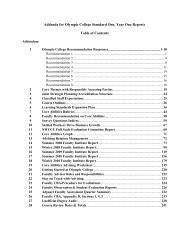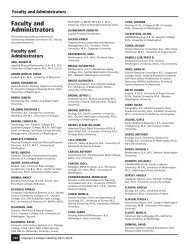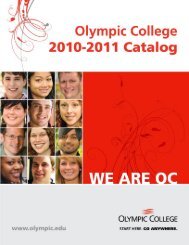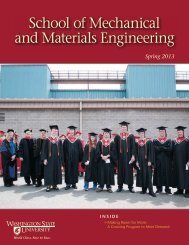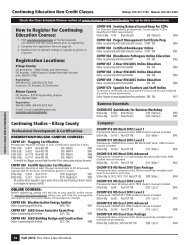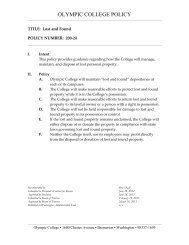HSS LEED Education Brochures - Olympic College
HSS LEED Education Brochures - Olympic College
HSS LEED Education Brochures - Olympic College
You also want an ePaper? Increase the reach of your titles
YUMPU automatically turns print PDFs into web optimized ePapers that Google loves.
Sustaining our Future<br />
Phot<br />
o by Justin<br />
Pear<br />
son<br />
Copyrigh<br />
t©2010<br />
Humanities and Student Services Building
United States Green Building Council’s Commitment to Sustainable Design<br />
• The <strong>LEED</strong> building program, developed by the US Green Building Council (USGBC), certifies buildings through<br />
documentation and third party review in six categories: Sustainable Sites (SS), Water Efficiency (WE), Energy and<br />
Atmosphere (EA), Materials & Resources (MR), Indoor Environmental Quality (IEQ), and Innovation & Design (ID).<br />
Buildings receive a rank of Certified, Silver, Gold, or Platinum.<br />
Washington State’s Commitment to Sustainable Design<br />
• In 2005 the State of Washington committed to achieve a minimum of <strong>LEED</strong> Silver for Major Facility Projects built with<br />
State capital construction funds. The Humanities and Student Services (<strong>HSS</strong>) building is the first project at <strong>Olympic</strong><br />
<strong>College</strong> constructed under this program.<br />
<strong>Olympic</strong> <strong>College</strong>’s Commitment to Sustainable Design – Sustaining our Future<br />
• <strong>LEED</strong> Certification and Energy Usage: The <strong>College</strong> has completed a comprehensive energy audit of existing buildings<br />
with implementation underway to record energy usage and install energy savings equipment.<br />
• Climate Change: In 2008, <strong>Olympic</strong> <strong>College</strong> President Dr. David Mitchell signed the American <strong>College</strong> and University<br />
Presidents Climate Commitment, pledging to exert leadership in addressing climate change and developing an<br />
institutional action plan to become carbon neutral.<br />
• Teaching: <strong>Olympic</strong> <strong>College</strong> has created an Environmental Studies Program, including Environmental Issues, Innovation<br />
in Design, and Mathematics and the Environment. The Culinary Arts program offers sustainable menu items at the<br />
<strong>College</strong>’s restaurant.<br />
• Student Engagement: Students created and manage two hands-on learning and service clubs: The <strong>Olympic</strong> <strong>College</strong><br />
Environmental Outreach Club and Veteran’s Environmental Club.<br />
• Community Outreach: The <strong>College</strong> sponsors community forums to indentify the workforce skills needed in a Green<br />
Economy.<br />
Humanities and<br />
Student Services (<strong>HSS</strong>)<br />
Leadership in Energy and<br />
Environmental Design (<strong>LEED</strong>)<br />
Green Building practices can substantially reduce the impact of a<br />
building on the environment throughout its entire lifecycle, while<br />
creating an indoor environment that promotes the health and well<br />
being of the occupants.<br />
Sustaining our Future
Responsible Land Consumption<br />
• Site Selection - Preserves farmland, parks, waterways and wildlife habitats by redeveloping a previously used site. This site<br />
is the former home of the 55 year-old Math-Science building.<br />
• Brownfield Redevelopment - Responsible and thorough remediation of potentially hazardous materials, such as asbestos<br />
and contaminated soils, from the site.<br />
Protect Ecosystems<br />
• Erosion and Sedimentation Control - Responsible control of pollution, sedimentation, and erosion resulting from<br />
construction activities.<br />
• Light Pollution Reduction - Reduces sky glow to improve night visibility and protect the nocturnal environment through the<br />
use of “cut-off” or downward focused exterior lighting.<br />
• Heat Island Effect - Reduces heat islands to minimize the impact on microclimates by the use of reflective surfaces, shading<br />
devices, and landscaped areas. Over 90% of the roof is highly reflective and over 30% of the non-roof impervious surfaces<br />
will be shaded within five years.<br />
• Reduced Site Disturbance - Protects open space and limits the development footprint by dedicating open space adjacent to<br />
the building equal to the building footprint.<br />
Preserve Natural Resources<br />
• Development Density - Reduces automobile travel by locating the project within an urban area with easy access to local<br />
services, taking advantage of existing utility infrastructure.<br />
• Alternative Transportation - Reduces automobile travel by providing links to public transit services, providing infrastructure<br />
for bicycle use, and building no new automobile parking.<br />
Humanities and<br />
Student Services (<strong>HSS</strong>)<br />
Sustainable Sites<br />
The environmental impact of a new building begins with the<br />
selection of the site and is dependant upon how the site is treated<br />
both during and after construction.<br />
Sustaining our Future
Minimize Use of Potable Water for Irrigation<br />
• Water Efficient Landscaping - Reduces the amount of potable water used for landscaping by 50% through the use of native,<br />
drought tolerant plants and drip tube irrigation systems.<br />
Minimize Burden on Municipal Water Supply & Wastewater System<br />
• Water Use Reduction - Minimizes burden on municipal water supply and wastewater system by reducing water consumption<br />
to 30% below the requirements of the Energy Policy Act of 1992 through the use of low-flow plumbing fixtures.<br />
Humanities and<br />
Student Services (<strong>HSS</strong>)<br />
Water Efficiency<br />
Water reduction strategies not only reduce the depletion of rivers,<br />
streams, reservoirs, and aquifers, but also result in lower operating<br />
costs for the building.<br />
Sustaining our Future
Reduction of Environmental Impact by Design<br />
• Minimum Energy Performance - Establishes a minimum level of energy efficiency for the building.<br />
• CFC Reduction in HVAC & R equipment - Reduces ozone depletion by specifying air conditioning equipment that does not<br />
use CFC-based refrigerants.<br />
• Optimize Energy Performance - Reduces environmental impact by reducing energy consumption 30-40% from the<br />
established baseline. Lighting efficiency is achieved through the use of energy efficient direct/indirect<br />
light fixtures and a lighting control system with occupancy and daylight sensors to turn off lights when not needed. Heating<br />
and cooling efficiency is met by increased wall and roof insulation, operable windows, sunshades on the south side to<br />
reduce glare and heat gain, and heat exchangers to capture the heat from exhaust air and use it to pre-heat incoming air.<br />
Verification that Systems are Performing Optimally<br />
• Fundamental Building Systems Commissioning - Optimizes energy performance by verifying the building’s energy related<br />
systems are installed, calibrated, and performing to design.<br />
• Additional Commissioning - Further optimizes energy performance by providing an independent commissioning agent,<br />
beginning the commissioning process early in design, ensuring proper training for maintenance staff, and verifying<br />
performance 8-10 months after the initial verification is complete.<br />
Humanities and<br />
Student Services (<strong>HSS</strong>)<br />
Energy & Atmosphere<br />
Conventional methods of generating electricity have huge<br />
environmental impacts. Green buildings reduce the amount of<br />
electricity required and promote more favorable forms of electrical<br />
generation.<br />
Sustaining our Future
Divert Waste from Landfills<br />
• Storage and Collection of Recyclables – Facilitates the reduction of waste generated by building occupants through easy<br />
access to space for collection and storage of recyclables, i.e. paper, cardboard, glass, and plastics.<br />
• Construction Waste Management - Diverts demolition and construction debris from landfills by redirecting materials back<br />
to the manufacturing process and sending re-usable materials to appropriate sites. Over 95% of the Humanities & Student<br />
Services (<strong>HSS</strong>) building construction debris was recycled or re-used.<br />
Preserve Natural Resources<br />
• Recycled Content – The use of recycled materials reduces the impact of extraction and processing of virgin materials. Over<br />
10% of the content of the <strong>HSS</strong> building materials contained recycled materials.<br />
• Reduce Transportation Impacts and Support Local Economies through Regional Materials – The use of materials from near<br />
the project site limits the environmental impacts from transporting building products over long distances and supports local<br />
economies. Over 20% of the materials used in <strong>HSS</strong> were manufactured regionally and over 50% extracted regionally.<br />
Humanities and<br />
Student Services (<strong>HSS</strong>)<br />
Materials and Resources<br />
Green Building strategies work to facilitate recycling and material<br />
re-use, divert waste from landfills, promote the use of rapidly<br />
renewable resources, and limit the environmental impacts from the<br />
transportation of building products.<br />
Sustaining our Future
Indoor Air Quality Management<br />
• Minimum Indoor Air Quality (IAQ) Performance and Ventilation Effectiveness – Improves occupant comfort, well-being, and<br />
productivity by providing increased ventilation. The mechanical system for this project provides 100% outside air while meeting the<br />
energy efficiency goals described in Energy and Atmosphere.<br />
• Environmental Tobacco Smoke (ETS) Control – Protects building occupants from ETS by prohibiting smoking except for outside<br />
areas at least 25 feet away from doors, windows, and outside air intakes. <strong>Olympic</strong> <strong>College</strong>’s campus is non-smoking except for<br />
limited, designated outdoor smoking areas that meet this requirement.<br />
• Construction IAQ During and After Construction – Protects the building from sources of contamination during construction and<br />
prior to occupancy. The IAQ procedures minimized construction dust from entering the new mechanical systems through the use of<br />
protective wraps and filters, and protected absorptive materials such as insulation, carpet, ceiling tile, and drywall from moisture. After<br />
construction, the building was flushed out with large quantities of 100% outside air prior to occupancy.<br />
Indoor Materials and Controlling Potential Sources of Pollution<br />
• Low Emitting Materials – Reduces the quantity of indoor air contaminates that are odorous or potentially harmful to occupants. All<br />
building materials installed inside the building were selected and documented to be low in volatile organic compounds (VOC’s),<br />
including adhesives, sealants, paint, carpet, and composite wood products.<br />
• Indoor Chemical & Pollution Source Control – Reduces the source of potentially hazardous particulates and chemicals. Permanent<br />
walk-off mats are provided to control the entry of dust and dirt into the building. Housekeeping spaces where cleaning products are<br />
stored are exhausted directly to the exterior.<br />
Control and Comfort of Systems<br />
• Controllability of Systems, Lighting and Thermal Comfort – Provides a high level of control for multi-occupant spaces and individual<br />
controls in private spaces. Lighting and thermal comfort in group spaces are monitored and controlled by digital systems that respond<br />
to the environment, such as natural daylight. Individual controls and operable windows are provided in private spaces.<br />
• Thermal Comfort – Establishes thermal comfort criteria during design and provide a monitoring system toverify building performance.<br />
The digital temperature controls system records trends to evaluate against established criteria.<br />
Humanities and<br />
Student Services (<strong>HSS</strong>)<br />
Indoor Environmental<br />
Quality<br />
Buildings need to be healthy for those who inhabit them, contributing to<br />
the comfort, well-being, and productivity of the occupants. This includes<br />
the selection of materials, control of potential sources of contamination,<br />
and allowing the occupants control over their environment.<br />
Sustaining our Future
Innovation<br />
• Green Building <strong>Education</strong> – Increase the awareness of sustainable building design practices to the occupants and the<br />
community at large. The Humanities and Student Services (<strong>HSS</strong>) building offers educational displays and <strong>Olympic</strong> <strong>College</strong><br />
provides educational tours for public groups.<br />
• Integrated Pest Management – Reduces exposure to chemicals for building occupants and maintenance staff. The goal<br />
of integrated pest management is to prevent pest situations inside and outside the building through education, policies<br />
and procedures, and reducing/eliminating the use of chemicals. <strong>Olympic</strong> <strong>College</strong> has a program in place that achieves<br />
these goals.<br />
• Green Housekeeping – The use of green housekeeping practices helps to maintain a high level of indoor air quality for the<br />
health and welfare of the occupants and the custodial staff. <strong>Olympic</strong> <strong>College</strong> has a program to use cleaning compounds<br />
that are friendly to the environment.<br />
• <strong>LEED</strong> Accredited Professional – A <strong>LEED</strong> Accredited Professional helps ensure the <strong>LEED</strong> process is correctly and<br />
effectively followed from the beginning of design through construction. The <strong>HSS</strong> Project Team included a professional<br />
<strong>LEED</strong> consultant who monitored the process, provided consultation for the design and construction team, and compiled the<br />
formal documentation submitted to the US Green Building Council.<br />
Exemplary Performance<br />
• Construction Waste Management – Thanks to the diligent efforts of the construction contractor and the many construction<br />
workers on a day-to-day basis throughout construction, the <strong>HSS</strong> project exceeded the Material and Resources Credits for<br />
Construction Waste Management by diverting over 95% of the construction debris from landfills to be recycled or re-used.<br />
This earned the project an Exemplary Performance credit.<br />
Humanities and<br />
Student Services (<strong>HSS</strong>)<br />
Innovation & Design<br />
<strong>LEED</strong> provides an Innovation & Design Category to encourage new<br />
technologies and methods of sustainable design practices that are<br />
not yet formally recognized in the <strong>LEED</strong> process. This category also<br />
recognizes Exemplary Performance (EP) in an area that exceeds one<br />
of the established credits.<br />
Sustaining our Future
1600 Chester Ave<br />
Bremerton, WA 98337<br />
Printed on recycled paper.



